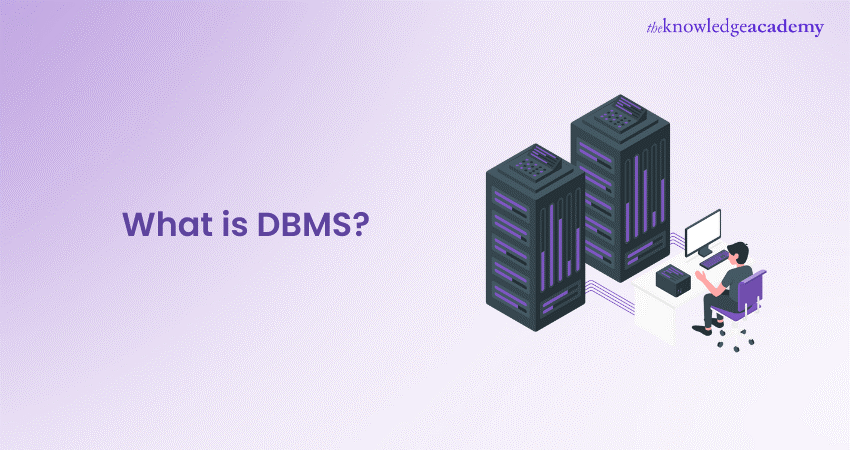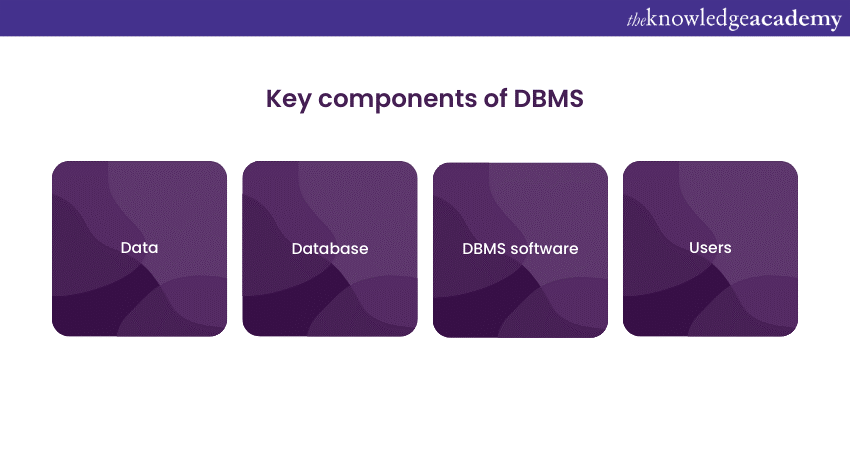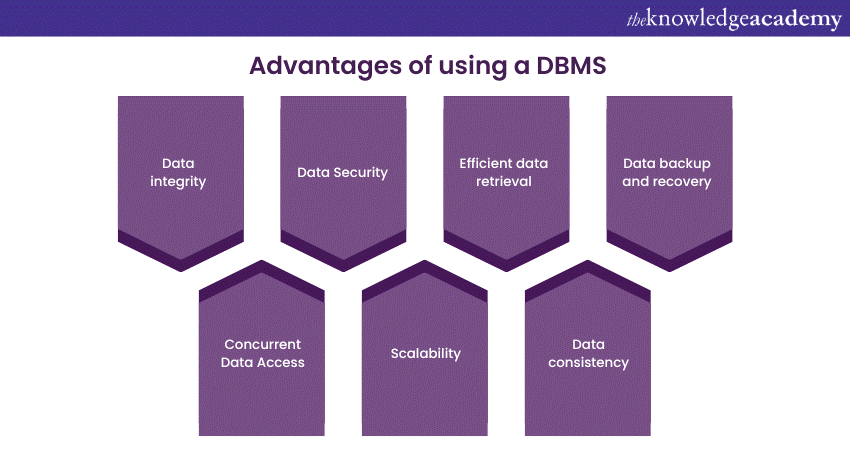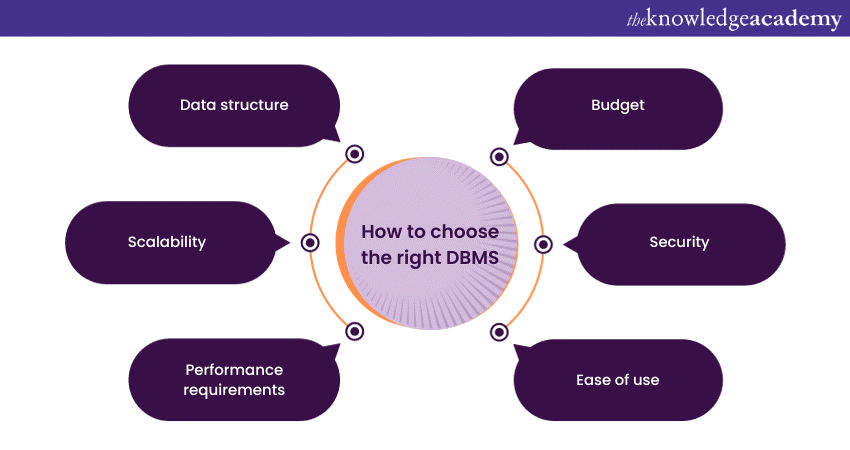We may not have the course you’re looking for. If you enquire or give us a call on +44 1344 203999 and speak to our training experts, we may still be able to help with your training requirements.
We ensure quality, budget-alignment, and timely delivery by our expert instructors.

When it comes to information and technology, data is at the heart of almost every process and application. To effectively manage and manipulate data, businesses and organisations rely on a fundamental tool called "Database Management Systems (DBMS)". But What is DBMS? Let's find out together.
From e-commerce websites to hospital records, Database Management Systems play a pivotal role in Decision-Making and Operations. If you are interested in learning more about DBMS, then this blog is for you. In this blog, you will learn What is DBMS, its different types, advantages, use cases and challenges. Let’s dive in deeper to learn more!
Table of Contents
1) What is DBMS definition?
2) Types of DBMS
3) Advantages of using a DBMS
4) Use cases of Database Management Systems
5) Challenges and considerations of DBMS
6) Choosing the right DBMS
7) Conclusion
What is DBMS definition?
At its core, a Database Management System (DBMS) is a software application designed to store, retrieve, manage, and manipulate data efficiently. These systems act as intermediaries between users and databases, providing an interface for End Users to interact with the data stored within.
In essence, a DBMS serves as a data organisation and control system, ensuring that data remains accurate, accessible, and secure. It achieves this by employing a structured approach to Data Management, which includes the creation, maintenance, and optimisation of databases.
Key Components of a DBMS
A Database Management System (DBMS) is a complex software system that consists of several key components working together seamlessly to ensure efficient data management. Understanding these components, including the Types of Keys in DBMS, is crucial for grasping how it operates. Here are the key components of a DBMS:

1) Data: The lifeblood of any DBMS is the data it manages. Data can take many forms, including text, numbers, multimedia, and more. It stores and retrieves this data efficiently.
2) Database: A database is a structured Data Collection that is organised for easy access and management. It serves as the primary repository for an organisation's data.
3) DBMS software: The software component of a DBMS is responsible for managing data operations. It includes tools and utilities for creating, modifying, querying, and securing data.
4) Users: Users interact with the DBMS to perform various tasks, such as querying the database, adding data, and generating reports. Different types of users have different levels of access and permissions.
Understanding these components is vital for both database administrators and developers to harness the power of a DBMS effectively.

Types of DBMS
DBMS can be categorised into different types based on their structure and functionality. Each type is designed to address specific data management needs. Here are some common types of DBMS:
1) Relational DBMS (RDBMS): These systems store data in tables with rows and columns, which are interconnected using keys or relationships. RDBMS systems use a structured query language (SQL) for data manipulation. Examples include MySQL, Oracle, and Microsoft SQL Server.
2) NoSQL DBMS: NoSQL databases are designed for handling unstructured or semi-structured data. They offer flexibility and scalability, making them suitable for applications where the data schema is not well-defined or subject to frequent changes. Examples include MongoDB and Cassandra.
3) Object-Oriented DBMS (OODBMS): OODBMS stores data as objects, making them ideal for applications with complex data structures, like those that involve inheritance and polymorphism.
4) Graph DBMS: These databases are specialised in managing data with complex relationships, such as social networks, recommendation engines, and knowledge graphs. They are highly efficient for querying and traversing interconnected data. Neo4j is an example of a graph DBMS.
5) Columnar DBMS: Columnar databases store data in columns rather than rows, which is optimised for analytical queries. This design enhances performance in data warehousing and business intelligence scenarios. Popular examples include Amazon Redshift and Google BigQuery.
6) XML DBMS: XML databases are designed to manage XML data, which is commonly used to represent semi-structured data. These systems are capable of efficiently storing and querying XML documents.
7) Time-series DBMS: Time-series databases specialise in handling data that is indexed or organised by timestamps, such as sensor data, financial time series, and IoT (Internet of Things) data. InfluxDB is an example of a time-series DBMS.
8) NewSQL DBMS: NewSQL databases aim to combine the best features of traditional RDBMS with the scalability and performance of NoSQL databases. They are designed to handle high-throughput and low-latency transactions while maintaining ACID (Atomicity, Consistency, Isolation, Durability) compliance.
Each type of DBMS has its own strengths and weaknesses, making it suitable for specific use cases. The choice of a DBMS type depends on factors such as the nature of the data, performance requirements, scalability needs, and the overall goals of the application or organisation.
Sculpt your data into brilliance with our Relational Databases & Data Modelling Training – Sign up now!
Advantages of using a DBMS
The adoption of a database Management System (DBMS) offers a wide range of advantages for organisations and businesses of all sizes. These advantages contribute to more efficient and effective data management. Here are some key benefits:

1) Data integrity: DBMS systems ensure data accuracy and consistency by enforcing validation rules and constraints, reducing errors.
2) Data Security: DBMS systems provide robust security, protecting data through user authentication, access control, and Data Encryption.
3) Efficient data retrieval: DBMS systems optimise data access using indexing and query optimisation, ensuring quick retrieval of information.
4) Data backup and recovery: Most DBMS systems offer automated data backup and recovery mechanisms to safeguard against data loss.
5) Concurrent Data Access: DBMS systems manage multiple users accessing and modifying data simultaneously, reducing conflicts.
6) Scalability: DBMS systems can scale to accommodate growing Data and user demands, supporting organisational growth.
7) Data consistency: DBMS systems enforce data consistency, ensuring reliable and up-to-date information for users.
Overall, DBMS systems are essential tools for effective data management. They play a pivotal role in maintaining data accuracy, security, and accessibility. It helps contribute to better Decision-Making and increase the overall efficiency of an organisation's operations.
Use cases of Database Management Systems What is DBMS definition?
Database Management Systems (DBMS) find extensive applications across various industries and organisations. Let's explore its use cases:
1) Business and enterprise applications: DBMS is used to manage and store data for business operations, including customer information, product catalogues, sales transactions, and employee records. It enables efficient data retrieval and supports applications like Enterprise Resource Planning (ERP) and Customer Relationship Management (CRM).
2) Healthcare: In the healthcare industry, DBMS is crucial for managing patient records, medical histories, diagnoses, and treatment plans. It ensures data accuracy and accessibility, which is vital for patient care and compliance with healthcare regulations.
3) Finance and Banking: Banks and financial institutions rely on DBMS to handle vast amounts of data, including customer accounts, transactions, loans, and investments. DBMS ensures data accuracy, supports online transactions, and helps maintain compliance with financial regulations.
4) Retail and e-commerce: E-commerce websites use DBMS to manage product catalogues, inventory, order processing, and customer data. It enables efficient data retrieval and secure online transactions.
5) Supply Chain Management: DBMS plays a crucial role in managing the flow of goods and services within the Supply Chain Management. It helps track inventory, orders, deliveries, and logistics, ensuring cost-effective operations.
These diverse use cases highlight the versatility and importance of DBMS in modern organisations and industries. Efficient data management is essential for decision-making, compliance, and operational success, and that's where it shines.
Chart your course to data mastery with our Introduction to Database Training – Sign up now!
Challenges and considerations of DBMS
While DBMS offers numerous benefits, there are challenges and considerations to keep in mind. Let’s take a look at some of them below:
1) Cost: Implementing and maintaining a DBMS can be expensive, including software licensing, hardware, and personnel.
2) Complexity: Learning to use a DBMS like SQL Databse effectively can be complex. So, organisations may need to invest in training.
3) Data Security: Protecting sensitive data is a constant challenge as hackers continually develop new attack methods.
4) Data modelling: Proper data modelling is essential for a successful DBMS implementation. A poorly designed database can lead to performance issues.
Choosing the right DBMS
Selecting the appropriate Database Management System is a critical decision for organisations, as it directly impacts data management, performance, and scalability. Here are key considerations for choosing the right DBMS:

1) Data structure: Consider the nature of your data, whether it's structured, unstructured, or semi-structured.
2) Scalability: Evaluate your organisation's current and future data growth to choose a DBMS that can scale accordingly.
3) Performance requirements: Some applications require high-speed data retrieval, while others prioritise data consistency.
4) Budget: Weigh the costs associated with acquiring and maintaining a DBMS against the benefits it provides.
5) Security: Prioritise Big Data Security by selecting a DBMS with robust security features, user authentication, access control, and encryption.
6) Ease of use: Consider the ease of use and learning curve for your team, as well as the availability of documentation and community support.
These key considerations in Database Management System Ebook will guide you in choosing the right DBMS that aligns with your organisation's data management needs and long-term goals.
Boost your DBMS interview prep with the ultimate DBMS Interview Questions and Answers—download now and start studying!
Conclusion
We hope you read and understand What is DBMS and its advantages. Database Management Systems are pivotal for streamlined data management. Their role in enhancing data integrity, security, and accessibility is undeniable. One crucial process within DBMS is Decomposition in DBMS, which ensures that data is efficiently organised and stored in a way that preserves relationships and reduces redundancy. Additionally, Serializability in DBMS plays a crucial role in maintaining the consistency and correctness of transactions within a database. Careful DBMS selection, considering aspects like serializability, is the cornerstone of effective data utilization, fostering informed decision-making and operational efficiency.
Unlock the power of data with our Database Training – Sign up today
Frequently Asked Questions
What are the Other Resources and Offers Provided by The Knowledge Academy?

The Knowledge Academy takes global learning to new heights, offering over 3,000 online courses across 490+ locations in 190+ countries. This expansive reach ensures accessibility and convenience for learners worldwide.
Alongside our diverse Online Course Catalogue, encompassing 19 major categories, we go the extra mile by providing a plethora of free educational Online Resources like News updates, Blogs, videos, webinars, and interview questions. Tailoring learning experiences further, professionals can maximise value with customisable Course Bundles of TKA.
Upcoming Programming & DevOps Resources Batches & Dates
Date
 Introduction to Database Training
Introduction to Database Training
Fri 21st Mar 2025
Fri 2nd May 2025
Fri 29th Aug 2025
Fri 3rd Oct 2025
Fri 5th Dec 2025






 Top Rated Course
Top Rated Course


 If you wish to make any changes to your course, please
If you wish to make any changes to your course, please


